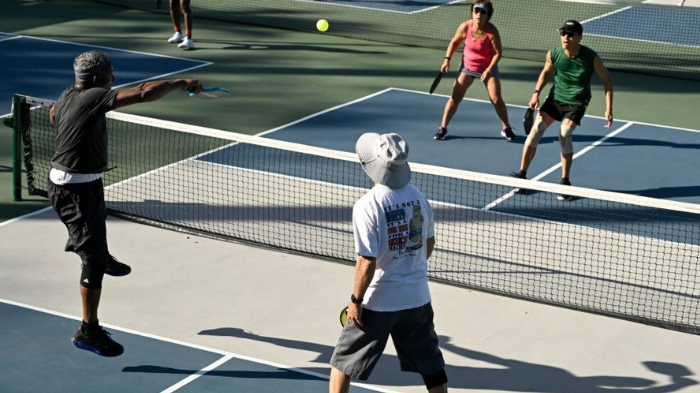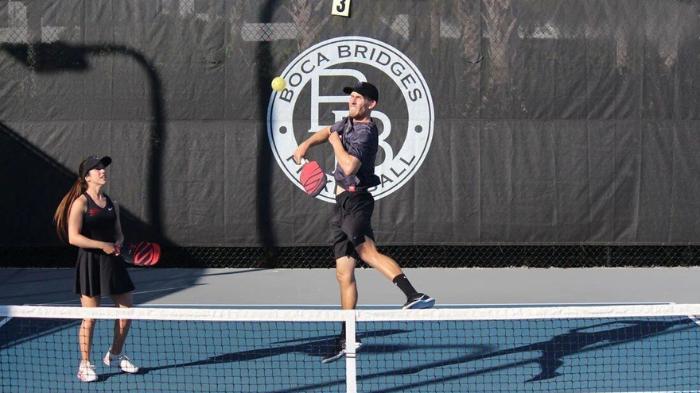If you’re unfamiliar with what poaching in pickleball entails, you’ve come to the right place. In this blog post, we are going to define what is poaching in pickleball. Poaching is a deliberate strategy players use to gain an edge over their opponents.
After that, we are going to explain the pros and cons of poaching in pickleball, when to poach in pickleball, situations where you don’t have to utilize pickleball poaching, and guide you regarding how to poach in pickleball.
What Do You Mean by Poaching in Pickleball?
In pickleball doubles, “poaching” is a strategy where a player leaves their spot to intercept and hit a shot intended for their partner. The goal is to surprise the opponents and put them under pressure.
When players anticipate that their partner’s shot will be weak or within easy reach, they employ the poaching strategy. This involves swiftly moving towards the middle of the court or crossing over to their partner’s side to seize the shot. The aim is to gain control and deliver a more aggressive or unexpected return. The poaching strategy creates a disturbance in the opponents’ rhythm, necessitates adjustments to their shots, and creates openings for potential winning plays.

Nevertheless, poaching does come with certain risks. If the player attempting the poach misjudges the shot or fails to execute a successful return, it can leave their side of the court exposed and susceptible to exploitation by the opponents. Effective communication, anticipation, and coordination between the doubles partners are essential to execute poaching successfully.
It is important to note that poaching is specific to doubles play in pickleball and is not applicable to singles play, where there is only one player on each side of the court.
Pros and Cons of Poaching in the Pickleball Game
Poaching is a strategic maneuver used in pickleball doubles where a player moves from their position to intercept and return a shot intended for their partner. While it can be an effective tactic, it also comes with its own set of pros and cons. Let’s explore the advantages and disadvantages of poaching in the game of pickleball.
Pros Of Poaching In Pickleball:
Surprise Factor: Poaching can catch opponents off guard, creating a surprise element that disrupts their rhythm and strategy. It can lead to unexpected returns that the opponents may struggle to anticipate or respond to effectively.
Increased Pressure: By intercepting shots intended for their partner, poaching players apply additional pressure on the opponents. This can force them to adjust their shots quickly, potentially resulting in mistakes or weak returns.
Offensive Advantage: When players poach in pickleball, they seize the chance to control the shot and potentially make a more forceful or surprising return. This creates opportunities for scoring points and forces the opponents to adopt a defensive stance, giving the poaching team an advantage in their offensive gameplay.
Cons Of Poaching In Pickleball:
Risk Of Leaving The Court Vulnerable: When players engage in poaching in pickleball, they move away from their designated position, which can leave the court susceptible and open to attacks. If the poaching player miscalculates the shot or fails to execute a successful return, it can create opportunities for the opponents to take advantage of the open spaces and score points.
Communication Challenges: Successful poaching in pickleball relies heavily on effective communication and coordination with one’s partner. If there is a lack of clear communication or if the partner is not ready for the poach, it can result in confusion, missed chances, or even collisions on the court.
Timing And Execution: Poaching requires precise timing and execution. If the poaching player mistimes their movement or fails to execute a successful return, it can result in missed shots or errors, giving an advantage to the opponents.
When to Poach to Win Points on the Pickleball Court
Here’s a further explanation of the situations when to poach on the pickleball court for winning points:
Anticipating A Weak Shot From The Opponent:
When you notice that your opponent is about to hit a shot that is likely to be weak or easily reachable, it presents an opportunity to poach. By intercepting the shot intended for your partner, you can take control and potentially deliver a stronger or more aggressive return, increasing your chances of winning the point.

Recognizing An Opening Or Vulnerability In The Opponents’ Positioning Or Shot Placement:
If you spot a gap or weakness in your opponent’s positioning or shot placement, it indicates an opportunity for poaching. By swiftly moving to intercept the shot, you can exploit the opening and apply pressure on your opponents. This tactical maneuver can potentially result in a victorious outcome for you.
Identifying Repetitive Patterns In The Opponents’ Gameplay:
If you observe that your opponents repeatedly use the same types of shots or follow predictable patterns in their gameplay, it can work to your advantage. By recognizing these patterns, you can anticipate the direction of their shots and strategically poach to intercept the ball. This disrupts your opponent’s rhythm and creates an opportunity for you to score.
Reading Cues And Signals From The Opponents Indicating A Predictable Shot:
Pay attention to the cues and signals your opponents give before hitting a shot. This can include body language, positioning, or the direction of their paddle. If you can read these cues and anticipate their shot selection, you can poach at the right moment to intercept the ball and gain an advantage.
Observing An Opportunity To Surprise And Disrupt The Opponents’ Rhythm:
Sometimes, the element of surprise can be an effective strategy. If you see an opportunity to catch your opponents off guard and disrupt their rhythm, it can be a good time to poach. By quickly moving to intercept the shot, you can introduce an unexpected element into the play and gain an advantage.
In summary, these situations provide opportunities for poaching in pickleball. By being aware of weak shots, vulnerabilities in opponents’ positioning, repetitive patterns, cues and signals, and chances to surprise the opponents, you can strategically poach and increase your chances of winning points on the pickleball court.
When to Not Poach in Pickleball
In pickleball, poaching refers to when a player at the net crosses over into their partner’s side of the court to intercept a shot. While poaching can be an effective strategy to surprise opponents and take control of the point, there are situations where it may not be advisable. Here are some scenarios where you should not consider poaching in pickleball:
Lack Of Communication: If you and your partner have not established clear communication or signals for poaching, it is best to avoid doing it. Poaching requires coordination and anticipation between partners to avoid confusion and potential collisions. Without proper communication, poaching can lead to errors and missed opportunities.
Weak Defensive Position: If you or your partner are not in a strong defensive position or are struggling to return the opponent’s shots, it is safer to stay at the net rather than attempting a poach. Poaching relies on having confidence in your partner’s ability to cover the court effectively. Therefore, if your partner is having difficulty, it is advisable to prioritize maintaining a solid defensive position.
Strong Opponent Returns: If the opponents consistently return shots with power and precision, it may not be the ideal time to poach. In such situations, your partner may need more support at the net to handle the challenging shots. Staying in position will help to ensure better court coverage and reduce the risk of leaving gaps for opponents to exploit.
Wide Angle Shots: When your opponents hit shots that go wide at an angle, forcing your partner to stretch and reach for them, it is generally not a good time to poach. Your partner will need additional time and space to recover from the wide shot. Trying to cross the court and poach in that situation can leave a gap open for the opponents to exploit.
Defensive Strategy: If you and your partner have a defensive strategy in place, it is possible that this strategy does not involve frequent poaching. Some players choose to stay near the net while their partner handles the backcourt. In such situations, deviating from the established strategy could disrupt the overall game plan and lead to errors.
Doubts About Shot Placement: If you’re unsure where your opponent’s shot will go, staying in your position is safer than guessing and possibly creating a gap. Before attempting a poach, it is crucial to accurately assess and understand the direction of your opponent’s shot.
Remember, the decision to poach or not depends on several factors, including your skills, communication with your partner, your opponent’s playing style, and the flow of the game. Effective poaching requires practice, coordination, and a good understanding of your partner’s strengths and weaknesses.
Steps on How to Poach in Pickleball
Poaching in pickleball refers to a strategy where a player moves quickly across the court to intercept an opponent’s shot intended for their partner. It can be an effective way to surprise your opponents and gain control of the point. Here is a step-by-step guide on how to poach in pickleball:
Understand The Positioning: In pickleball, the court is divided into left and right halves. You and your partner usually occupy one half of the court each, and the court is divided by a centerline. To execute a successful poach, you need to anticipate where your opponent will hit the ball and be ready to move.
Communicate With Your Partner: Before attempting a poach, communicate with your partner to let them know about your intention. This ensures that they know your movement and can adjust their positioning accordingly.
Read Your Opponent’s Shot: Watch your opponent’s body language, racket position, and shot preparation to anticipate where they will hit the ball. Look for cues such as the direction of their swing or the angle of their paddle to determine the potential shot placement.
Time Your Movement: When your opponent makes contact with the ball, it signals you to start moving towards the anticipated destination of the ball. The timing of your movement is crucial because if you start too early, your opponent can exploit the gap you leave open. On the other hand, if you begin your movement too late, you could miss the opportunity to intercept their shot. Therefore, achieving the correct timing is vital for a successful poach in pickleball.
Use Quick Footwork: Executing a successful poach in pickleball requires swift movement across the court, directing yourself towards the anticipated landing spot of the ball. To maintain balance and agility, it is important to take quick, small steps while navigating. It is equally important to maintain a slight bend in your knees, enabling rapid and effortless changes in direction as needed. By adhering to these techniques, you can improve your ability to execute poaches effectively during the game.
Position Yourself For Interception: As you approach the anticipated target area, position yourself between your opponent and your partner. This allows you to cut off the shot and intercept it before it reaches your partner.
Be Ready To React: Stay alert and be prepared to adjust your movement based on the shot. Be aware that your opponent has the ability to alter the direction or speed of the ball. Therefore, it is crucial to stay flexible and prepared to react accordingly.

Execute The Interception: Once you reach the interception point, use your paddle to block or redirect the shot. Aim to keep the ball low and controlled, ideally placing it away from your opponent’s reach or into an open space on the court.
Recover Quickly: After executing the interception, recover to your original position or adjust according to the new dynamics of the point. Reset your positioning and be ready for the next shot.
FAQs
When a player poaches, they temporarily leave their area to intercept the opponent’s shot. By doing so, they aim to disrupt the opponents’ rhythm, create defensive vulnerabilities, and gain an offensive advantage.
Yes, there are risks associated with poaching in pickleball. These risks include leaving the court vulnerable and creating defensive gaps if the opponents anticipate the poach pickleball or execute a well-placed shot. Additionally, communication challenges and the need for precise timing and execution can further increase the risks involved in poaching.
To enhance your poaching skills, focus on understanding positioning, communicating effectively with your partner, reading opponents’ shots, timing your movement, using quick footwork, positioning yourself for the interception, being ready to react, executing the interception, and recovering quickly.
No, poaching is not commonly employed in singles pickleball. Poaching is primarily utilized in doubles pickleball, where there are two players on each team. In singles play, the game dynamics and strategies are different, and the concept of poaching doesn’t apply in the same manner.
Conclusion
Poaching in pickleball can be a highly effective strategy if executed with proper timing, communication, and positioning. It offers the element of surprise, increases pressure on the opponents, and provides an offensive advantage. However, it also comes with disadvantages, such as leaving the court vulnerable, mistiming movements by a player, and communication challenges.
Understanding when to poach and when not to, as well as following the steps on how to poach in pickleball, will help you to incorporate this strategy into your pickleball game. After writing this blog, we hope you have understood the concept of what is poaching in pickleball, along with its pros and cons, when to use it for winning points in pickleball, when not to use it, and how to execute this technique. Hence, we strongly encourage you to practice diligently and strategically incorporate poaching into your pickleball game, as it can enhance your skills and take them to new heights.



